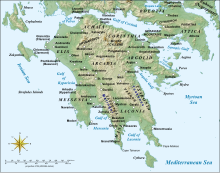Barony of Chalandritsa
Appearance
| Barony of Chalandritsa | |||||||
|---|---|---|---|---|---|---|---|
| Barony of the Principality of Achaea | |||||||
| 1209–1429 | |||||||
 Map of the Peloponnese with its principal locations during the late Middle Ages | |||||||
| Capital | Chalandritsa | ||||||
| Area | |||||||
| • Coordinates | 38°7′N 21°48′E / 38.117°N 21.800°E | ||||||
| • Type | Feudal lordship | ||||||
| Historical era | Byzantine reconquest | 1429 | |||||
| |||||||
The Barony of Chalandritsa was a medieval Frankish fiefdom of the Principality of Achaea, located in the northern Peloponnese peninsula in Greece, and centred on the town of Chalandritsa (Greek: Χαλανδρίτσα; French: Calandrice, Calendrice; Italian: Calandrizza; Aragonese: C[h]alandrica) south of Patras.[1]
History
The Barony of Chalandritsa was established ca. 1209, after the conquest of the
William II of Villehardouin and given to a knight named Guy of Dramelay, who had only recently arrived in the Morea. While otherwise reliable, the Aragonese version is considered erroneous in this regard.[5]
Robert's successor,
Battle of Cephissus in 1311.[7] The last baron of the family was Nicholas of Dramelay, whose exact familial relation with the other Dramelays is unknown. Like most Achaean magnates, he initially supported the infante Ferdinand of Majorca's bid for the princely throne in 1315, but switched back to Matilda of Hainaut when she arrived in the Morea in early 1316. He died a few weeks later, and Chalandritsa was occupied by Ferdinand's troops, who defended it with success against an attack by Matilda's husband, Louis of Burgundy.[8][9]
According to the Despot of the Morea, after a brief siege. Centurione was also forced to marry his daughter Catherine to Thomas, and retreated to his only remaining possession, the Barony of Arcadia, where he died in 1432.[13][14]
References
- ^ Bon (1969), p. 458
- ^ Miller (1921), pp. 71–72
- ^ a b c Bon (1969), pp. 107, 459
- ^ Topping (1975), p. 119
- ^ Bon (1969), pp. 107–108
- ^ Bon (1969), pp. 106 note 2, 459
- ^ Bon (1969), pp. 183, 234–235, 459
- ^ Bon (1969), pp. 192–193, 235, 459
- ^ Topping (1975), pp. 112–113, 119
- ^ Bon (1969), pp. 235, 459
- ^ Topping (1975), pp. 119–120
- ^ Bon (1969), pp. 205, 235–236, 460
- ^ Bon (1969), pp. 292–293, 460
- ^ Topping (1975), p. 165
Sources
- Bon, Antoine (1969). La Morée franque. Recherches historiques, topographiques et archéologiques sur la principauté d'Achaïe [The Frankish Morea. Historical, Topographic and Archaeological Studies on the Principality of Achaea] (in French). Paris: De Boccard. OCLC 869621129.
- OCLC 457893641.
- Topping, Peter (1975). "The Morea, 1311–1364". In ISBN 0-299-06670-3.
- Topping, Peter (1975). "The Morea, 1364–1460". In ISBN 0-299-06670-3.
